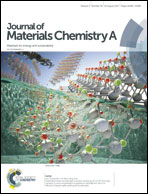1D nanobar-like LiNi0.4Co0.2Mn0.4O2 as a stable cathode material for lithium-ion batteries with superior long-term capacity retention and high rate capability†
Abstract
In this work is reported the successful synthesis of 1D nanobar-like LiNi0.4Co0.2Mn0.4O2 (N-NCM), preferentially exposing the {010} electrochemically active facets. The material is obtained via a precipitation process followed by a calcination step. Upon calcination at 800 °C, the material delivers a high initial reversible capacity of 177.1 mA h g−1 at 0.1C, while at higher current densities (1C, 2C, 5C and 10C), it still delivers 152.8, 141.7, 122.7 and 104.2 mA h g−1, respectively. After 100 cycles, the material exhibits high capacity retention values, ca. 91% (0.1C) and 94% (10C). The good electrochemical performance is attributed to the synthesis design strategy leading to 1D nanobars with exposed {010} electrochemically active facets, which provide a more open structure for unimpeded Li+ migration. In addition, the diffusion pathway of lithium ions is greatly reduced because of the nano-sized bar shape. All these factors play a decisive role in achieving significantly enhanced lithium ion diffusivity, and thus superior high C-rate capability and greatly improved long-term cycling stability.



 Please wait while we load your content...
Please wait while we load your content...